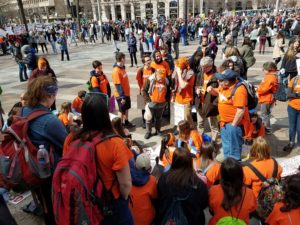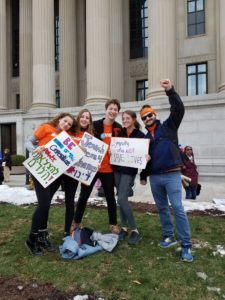Arriving at the DCJCC, I found the Twin Cities teens busily engaged in the poster prep for the march. Some of them I knew from previous work and volunteering with youth groups in the Twin Cities, but most I didn’t. The teens came from all walks of life in the Twin Cities, and every denomination was represented. We had teens from Adath Jeshurun, Bet Shalom, Beth El, Beth Jacob, Darchei Noam, Mount Zion, Shir Tikvah, Temple Israel, Temple of Aaron, regional NFTY and USY, and more. The funding was provided by the Minnesota Rabbinic Association, the Minneapolis and Saint Paul Federations and others – another example of collaboration.
The teens were spread about – we had been given relatively free rein of the J, but our home base was the racquetball and squash courts. The posters varied from nuanced looks at gun laws, to biblical quotes, to memes featuring Kim Kardashian. I was already impressed with the level of discourse these teens were exhibiting.
That evening, Kabbalat Shabbat was unique. I wouldn’t want to say that collaboration for the prayer services was without its bumps and its pressure points, but in the end it was a mishmash of minhag and melodies, and not everyone was comfortable the whole time. I think that may have been the (albeit unintentional) point – to demonstrate that we are united – and being united isn’t always clean, and it isn’t always perfect, but it is the most effective way to move things forward. Finding common ground, and being willing to compromise where it doesn’t diminish ones values.
That night, after dinner (graciously served by local volunteers from the DCJCC community) the teens gathered in the J’s theater to finish preparing themselves mentally and emotionally for the next day. They discussed what it means to protest, how to stay safe in that environment, and sharing with one another why they came. I had the privilege of speaking with the teens who had come alone or without a large contingency from their home congregation. I considered myself lucky to get to know these teens more personally and hear about their individual experiences which had brought them to this place. Finally, thoroughly exhausted, but anxious for the morning, the teens found their sleeping areas and bedded down. Just under 70 teenagers sprawled out in three racquetball courts, and a handful of us adults, also roughing it on the floor.
The March
The morning came too soon for some, and not soon enough for others. Everyone quickly readied themselves and dressed – matching orange shirts emblazoned with the text: #DAYENU. A handful of students met with a reporter from HuffPo, the staff chugged Starbucks, and the teens packed their backpacks with supplies for the day. We all walked together to meet up with the NFTY gathering to get ourselves pumped up and hear from some inspirational speakers as well as t’fillot. We said the mourner’s Kaddish together, remembering all of the victims of senseless gun violence and school shootings.
Now it was time to march.
We headed out of the building joining the already massive stream of folks flooding the streets from around the country. As we walked along more and more people representing every race, religion and geographic locale in our country could be seen. Celebrities were spotted, banners were carried, and together, over 800,000 strong, we arrived in front of our nation’s capital to begin making our voices heard.
If you’d like to hear about the program of the March itself, I am confident others will share that macro level of events. I can only tell you about my experience. Watching teens and the other marchers comfort one another as they burst into tears. Watching folks who didn’t even know each other help one another clamor up the walls of the National Archives for a better view. Watching a stage full of speakers, none of whom were much older than 18, and some of whom were as young as 11.

After over two hours of alternating between crying and cheering, the crowd finally began to disperse. The Twin Cities crew had long since gotten separated into smaller groups. We had planned for this, the kids had split themselves into smaller groups of 4 or 5. “My” group was a microcosm of the march, it seemed to me. Three girls and a boy from four different synagogues, and four different high schools had found each other and decided to be a group. I couldn’t have been more proud when they came up to the meeting point, sunburned, exhausted, and beaming with pride and emotion. We reconvened to say Kiddush in front of the National Archive building, as a unified group of folks from the Twin Cities, ignoring for once the differences between us – synagogue, movement, high school, age, background, city. As one we blessed the wine and sanctified our experience together.
Just the Beginning
As we walked back to the DCJCC, the teens were buzzing with their adrenaline and the rush of the march. They were debriefing with one another, sharing their unique experiences, and generally basking in the glow of one another’s strength. Arriving back at the J, the teens began cleaning and packing up, snacking a bit and getting ready for Havdallah and to board the buses. Havdallah was once again a mishmash of various traditions. It was clunky. It was emotional. It was the perfect way to end our March experience. Saying final goodbyes to the amazing and supportive staff of the DCJCC, the group vowed that this was only the beginning and already began discussing what moves would be made when they would get home. As a staff – a staff made up of secular and religious, men and women, young and old – we agreed to leave our differences aside and to empower these teens in every way we could. The model that I envision for the Twin Cities was demonstrated by these teens: a Jewish community less concerned with the denomination, geography, or institutional affiliation, and instead, laser-focused on making things happen.





Way to go Charley, staff and Jewish TEENS. Thank you for your energy and for taking action. We Jewish boomers have worked hard to model and teach important social justice and social action skills so we can pass the torch. May your efforts realize authentic change.